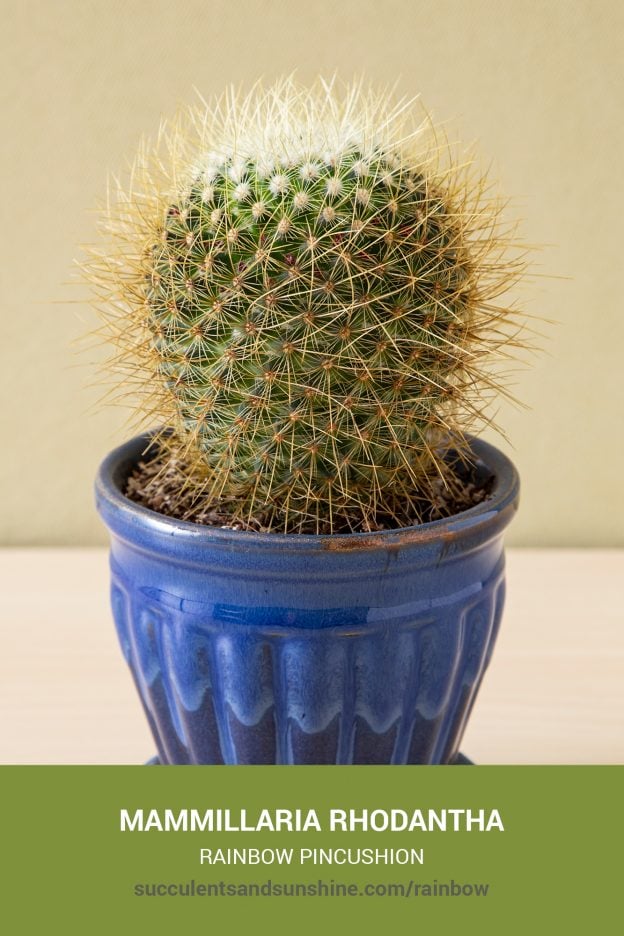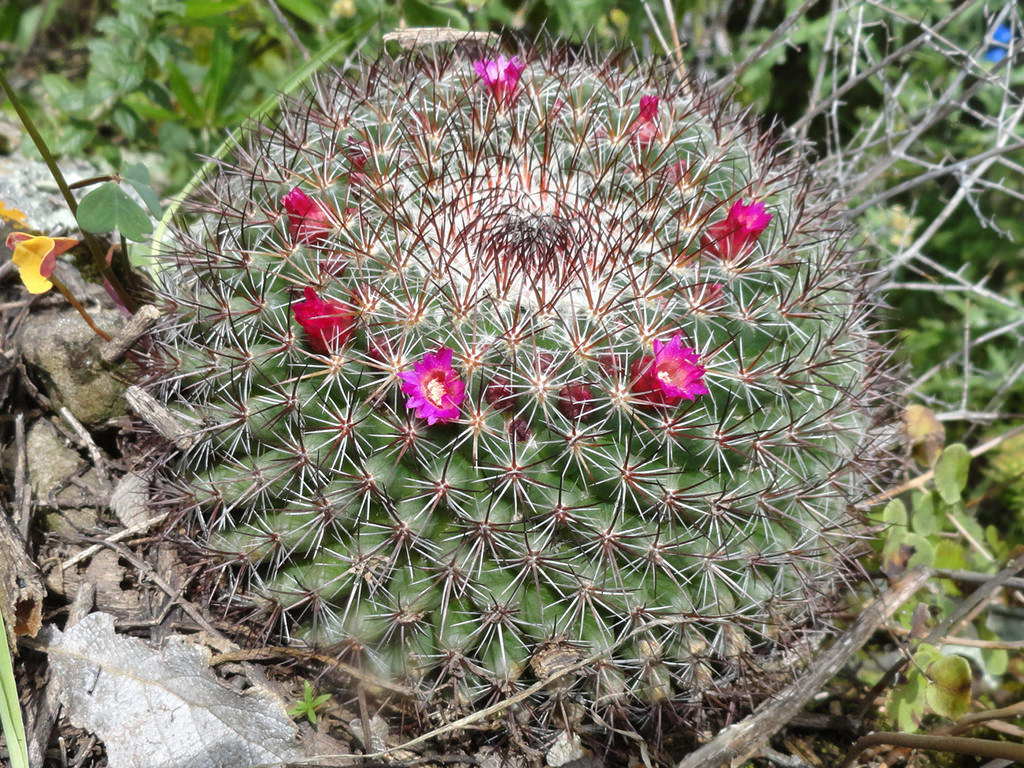This short, clumping cactus has stunning magenta blooms that last longer than many other types of cacti. It does well indoors, but should be kept away from pets and children as its spines are sharp.
Table of Contents
Care and Propagation Information

The “Rainbow Pincushion” cactus is an attractive addition to both indoor and outdoor succulent and cacti gardens, with its crown of blooms lasting from Spring to late Fall.
The entire body of the “Rainbow Pincushion” plant is covered in long, pointed spines, which become white or gray at the base. The top of the plant is covered in a soft, wool-like material.
Watering
Rainbow Pincushion requires less water than most succulents, so the best way to water it is to use the “soak and dry” method. Let the soil dry out completely between waterings, but remember to not water it at all during the Winter months.
Where to Plant
If you live in an area where temperatures drop below freezing (0° F, -17° C), it is best to keep Mammillaria rhodantha in a pot that can be brought inside during colder months. This succulent prefers partial sunlight to partial shade.
Put your plants in an area that receives both morning and afternoon sun if planting outdoors. For indoor plants, choose a spot that is exposed to a lot of sunlight, like a room with a south-facing window (if you’re in the Northern Hemisphere).
How to Propagate Mammillaria rhodantha “Rainbow Pincushion”
Mammillaria rhodantha “Rainbow Pincushion” is a fast-growing, clumping species that can produce many offsets when given ample space. It also blooms for extended periods, allowing mature plants to set fruit and generate seeds.
Offsets
The plant “Rainbow Pincushion” will produce offsets, which will sprout up around the base of the plant. It is important to take caution when removing these offsets. Refer to the instructions in this post to learn how to properly handle a cactus.
In order to propagate a clump, you will need to wear nitrile gloves, use silicone tongs, and have a sharp knife nearby.
Using the tongs, grip one of the cylindrical stems and carefully pull it away from the cluster. If the stem is too tough to separate without disturbing the rest of the plant, use the knife to cut through it.
Wait a few days for the end of the stem to form a protective layer before planting it in soil with good drainage.
Seeds
Once dry, you can plant the seeds in a well-draining soil mix and keep it lightly moist.
Plant your Mammillaria seeds in a soil that allows for good drainage. If you live in an area with a warm climate (zone 9a or higher), you can sow them outdoors. If you’re in a cooler region, you should start indoors under a grow light or on a heated seed mat.
Care and Propagation Information
General Care for Mammillaria rhodantha “Rainbow Pincushion”

The entire body of the “Rainbow Pincushion” plant is covered in long, pointed spines, which become white or gray at the base. The top of the plant is covered in a soft, wool-like material.
Watering
Rainbow Pincushion requires less water than most succulents, so the best way to water it is to use the “soak and dry” method. Let the soil dry out completely between waterings, but remember to not water it at all during the Winter months.
Where to Plant
If you live in an area where temperatures drop below freezing (0° F, -17° C), it is best to keep Mammillaria rhodantha in a pot that can be brought inside during colder months. This succulent prefers partial sunlight to partial shade.
Put your plants in an area that receives both morning and afternoon sun if planting outdoors. For indoor plants, choose a spot that is exposed to a lot of sunlight, like a room with a south-facing window (if you’re in the Northern Hemisphere).
How to Propagate Mammillaria rhodantha “Rainbow Pincushion”
Mammillaria rhodantha “Rainbow Pincushion” is a fast-growing, clumping species that can produce many offsets when given ample space. It also blooms for extended periods, allowing mature plants to set fruit and generate seeds.
Offsets
The plant “Rainbow Pincushion” will produce offsets, which will sprout up around the base of the plant. It is important to take caution when removing these offsets. Refer to the instructions in this post to learn how to properly handle a cactus.
In order to propagate a clump, you will need to wear nitrile gloves, use silicone tongs, and have a sharp knife nearby.
Using the tongs, grip one of the cylindrical stems and carefully pull it away from the cluster. If the stem is too tough to separate without disturbing the rest of the plant, use the knife to cut through it.
Wait a few days for the end of the stem to form a protective layer before planting it in soil with good drainage.
Seeds
Once dry, you can plant the seeds in a well-draining soil mix and keep it lightly moist.
Plant your Mammillaria seeds in a soil that allows for good drainage. If you live in an area with a warm climate (zone 9a or higher), you can sow them outdoors. If you’re in a cooler region, you should start indoors under a grow light or on a heated seed mat.
